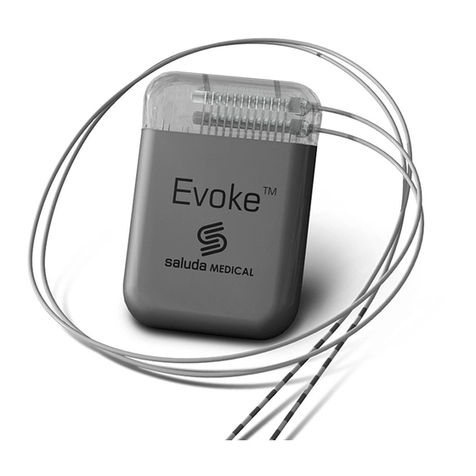
Evoke™ Clinical Manual
Document Reference: CLIN-UMAN-002424 Revision: 12.00 Page 2 of 56
Table of Contents
1DESCRIPTION .............................................................................................................. 4
1.1 THE CONCEPT OF FEEDBACK CONTROL (FC)......................................................................... 4
1.2 EVOKE CLOSED LOOP STIMULATOR (CLS) ........................................................................... 4
1.3 EVOKE EXTERNAL CLOSED LOOP STIMULATOR (ECLS)............................................................ 4
1.4 EVOKE 12C PERCUTANEOUS LEAD KIT,60CM AND 90CM ...................................................... 5
1.5 EVOKE 12C LEAD EXTENSION KIT,55CM ............................................................................ 5
1.6 EVOKE LEAD ADAPTER KIT ............................................................................................... 5
1.7 EVOKE POCKET CONSOLE (EPC) ....................................................................................... 5
1.8 EVOKE CHARGER ........................................................................................................... 5
1.9 EVOKE CLINICAL INTERFACE (CI) ....................................................................................... 5
1.10 EVOKE CLINICAL SYSTEM TRANSCEIVER (CST) .................................................................. 5
2PACKAGE CONTENTS................................................................................................... 6
2.1 EVOKE CLINICAL INTERFACE (CI) ....................................................................................... 6
2.2 EVOKE CLINICAL SYSTEM TRANSCEIVER (CST)...................................................................... 6
3INDICATION FOR USE .................................................................................................. 6
4CONTRAINDICATIONS ................................................................................................. 6
5WARNINGS AND PRECAUTIONS .................................................................................. 6
5.1 PRECAUTIONS ............................................................................................................... 6
6INTRODUCTION........................................................................................................... 8
6.1 EVOKE CLINICAL INTERFACE (CI) ....................................................................................... 8
6.2 EVOKE CLINICAL SYSTEM TRANSCEIVER (CST)...................................................................... 9
7CLINICAL INTERFACE – GENERAL PROGRAMMING USING THE CPA ............................. 9
7.1 CONNECTING THE CI TO THE CST AND ECLS/CLS................................................................. 9
7.2 SET STIMULATOR TIME .................................................................................................. 12
7.3 RETRIEVE OR SET THE PATIENT ID AND PATIENT ZONE.......................................................... 13
7.4 MEASURE ELECTRODE IMPEDANCE................................................................................... 14
7.5 SET UP LEAD ORIENTATION ............................................................................................. 15
7.6 PROGRAMMING OVERVIEW............................................................................................ 16
7.7 CHOOSE THE STIMULATION ELECTRODES AUTOMATICALLY ..................................................... 16
7.8 START AND STOP STIMULATION ....................................................................................... 17
7.9 SET UP ECAP MEASUREMENT......................................................................................... 19
7.10 SET UP FEEDBACK CONTROL (FC) THERAPY .................................................................... 20
7.11 ENABLE FEEDBACK CONTROL ...................................................................................... 21
7.12 SAVE A PROGRAM TO THE STIMULATOR......................................................................... 21
7.13 INTERLEAVED STIMULATION........................................................................................ 24
8CLINICAL INTERFACE – SETTINGS GUIDE.................................................................... 27
8.1 STIMULATION SETTINGS MENU....................................................................................... 27
8.2 MEASUREMENT AND FEEDBACK SETTINGS MENU ............................................................... 27
8.3 ELECTRODE SELECTION MODES ........................................................................................ 28
8.4 CURRENT STEERING ...................................................................................................... 28
8.5 PATIENT PERCEPTION.................................................................................................... 29
8.6 PATIENT SURVEY ......................................................................................................... 30
8.7 CLS MENU................................................................................................................. 31
8.8 NAVIGATION MENU ..................................................................................................... 33
8.9 SETTINGS MENU.......................................................................................................... 33
8.10 ALERT AND ERROR DISPLAY......................................................................................... 34
9INTRA-OPERATIVE PROGRAMMING WITH THE CI ..................................................... 35
































